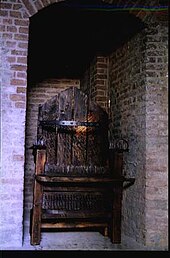Hester Jonas
Hester Jonas (* around 1570 in Monheim am Rhein ; † December 24, 1635 in Neuss ) was the so-called " Witch of Neuss". Her case is the most famous witch hunt in the history of the city of Neuss and was processed musically and lyrically in the 20th century .
Life
After marrying the Neuss miller Peter Meurer, Jonas moved to the windmill in Neuss. The Cologne War severely destroyed the city in 1585 and 1586 and more than halved its population to less than 2000 (cf. Neuss # becoming a town ). Jonas worked here as a midwife and used herbal medicine, including mandrake .
At the age of about 64, she was arrested, interrogated and tortured for sorcery in November 1635 . The Neuss mayor's court accused them of magic , apostasy from God, the pact with the devil and the devil's loyalty . Years before, Jonas had had a reputation for being a "witch".
At the first two interrogations on November 15 and 22, Jonas denied the allegations made against her. On December 19 and 20, she was put on a torture chair with iron nails for three hours each. After the torture , she made a "confession" at the request of the prosecution. She admitted that she had fornicated several times with a black man named "Hans Beelzebub" and harmed people and animals with magic. She is also possessed by the devil.
On the same night she managed to escape from the “Neuwachthaus”. However, she was seized a little later and locked in the mill tower. There she revoked her “confession”. Their resistance was broken again the following day by whipping them with “sharp rods”. After she confessed to all of the charges against her, the court sentenced her to death.
On December 24, 1635 , an executioner from Cologne beheaded Jonas in Neuss with the sword. Her body was cremated and her ashes were demonstratively distributed in all directions on the same day. Her husband had to pay 65 thalers for this.
As a special feature of the case, the interrogation protocol of the trial is completely preserved and can be viewed in the Neuss city archive.
reception
- Ballad von der Hester Jonas - Ballad by the Neuss-based poet Peter Maiwald (text by Gisela Götte, 1995, page 68)
- Ballade von der Hester Jonas - setting of the ballad as a song on the album Rauchzeichen by the Dortmund band Cochise (1979)
literature
- Hetty Kemmerich: Say what I should confess! Witch trials. Lessing Verlag, Dortmund 2004, ISBN 3-929931-18-4 , pages 231-236.
- Helmut Wessels: Neuss and St. Quirinus on foot. Bachem-Verlag , Cologne 2004, ISBN 3761618018 .
- Karl Tücking : History of the City of Neuss. Düsseldorf and Neuss 1891.
Web links
- Alexandra Kohlhöfer: A witch trial becomes a political issue. The case of Catharina Halffmans and the dispute between the city of Neuss and the archbishop in 1677. In: Contributions to city history. Stadtarchiv Neuss, pages 47-66 (PDF; 0.9 kB), accessed on April 28, 2016.
- Gisela Götte: "Judge once more" - The trial files of the sorceress Hesteren, Peter Meurer's housewife. In: Documentations of the Neuss City Archives, Volume 4 (B.01.02, V18): Neuss women in past and present. Stadt Neuss, Neuss 1995, pages 60–81 (PDF; 1.5 MB), accessed on April 28, 2016.
- Names of the victims of the witch trials / witch persecution in Neuss. List (PDF; 0.1 MB), accessed on November 11, 2017.
Individual evidence
- ↑ a b c Ulla Dahmen: City Archives: Gebuhlt with the Belzebub. Westdeutsche Zeitung , April 28, 2011, accessed on July 28, 2012 .
- ↑ Alexandra Kohlhöfer: A witch trial becomes a political issue. Stadtarchiv Neuss, contributions to the history of the town (PDF; 870 kB). Retrieved April 28, 2016 .
- ↑ a b Gisela Götte: "Judges once more" - The trial files of the sorceress Hesteren, Peter Meurer's housewife. Neuss women in the past and present, pages 60–81 (PDF; 1.5 MB). Stadtarchiv Neuss, 1995, accessed on July 31, 2019 .
- ↑ Ballad by the Hester Jonas. Song lyrics. inklusion-als-menschenrecht.de ( German Institute for Human Rights ), accessed on July 31, 2019 .
| personal data | |
|---|---|
| SURNAME | Jonas, Hester |
| BRIEF DESCRIPTION | Witch of Neuss |
| DATE OF BIRTH | around 1570 |
| PLACE OF BIRTH | Monheim am Rhein , Germany |
| DATE OF DEATH | December 24, 1635 |
| Place of death | Neuss , Germany |
